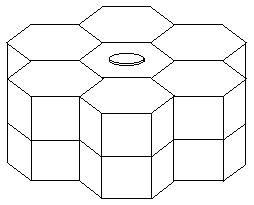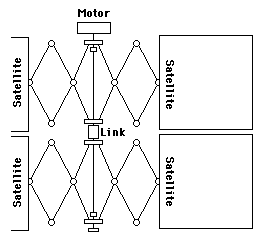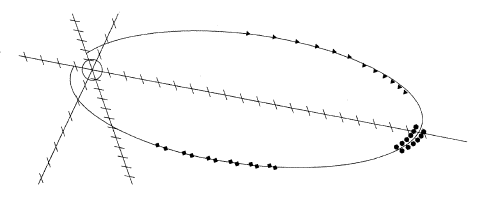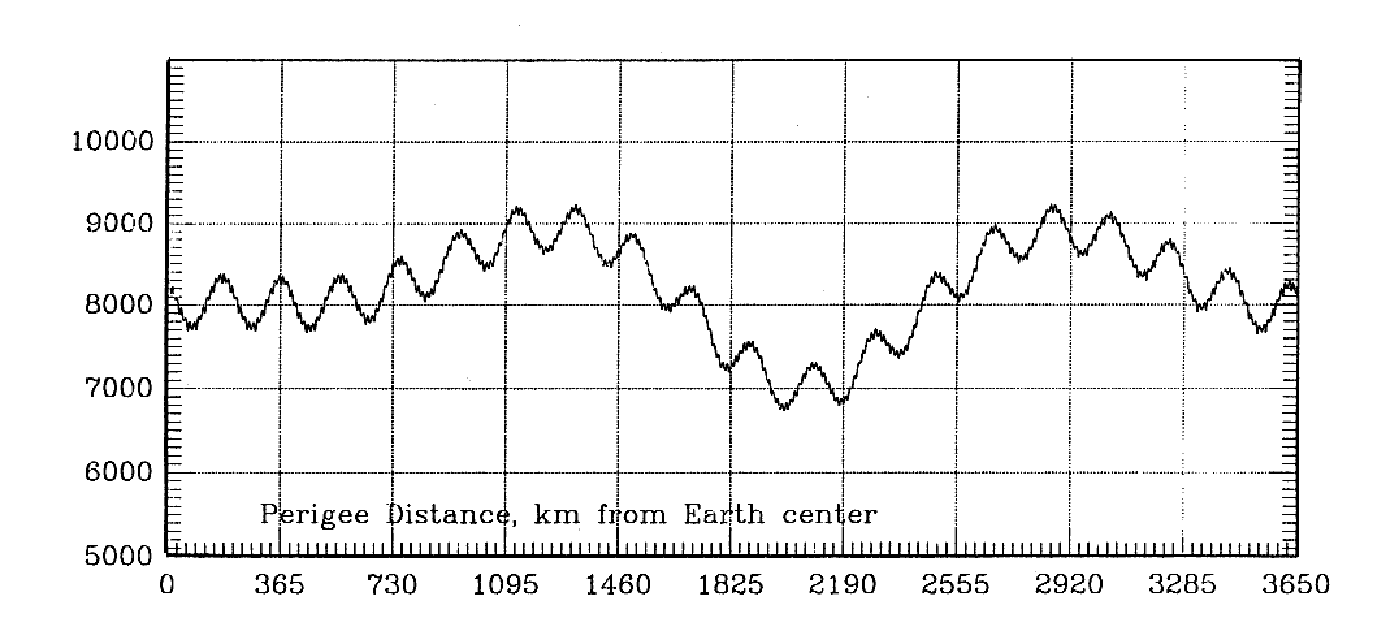Eclipses and the Phoenix Mode
Because even 3-hour eclipses cause severe chilling, and because batteries have a limited lifespan, one option of the "Profile" satellites is to adopt a completely battery-free design. It would invest weight in solar panels rather than in batteries, giving the transmitter enough power to download data without recourse to stored energy.
To prevent excessive cooling, thermal blankets would close the top and bottom of the hexagons, keeping the interior above -50° even in long eclipses. A small "keep alive" battery would be placed next to the memory and CPU, keeping them running and in the process generating enough heat to stave off freezing. If that battery fails, the satellite´s computer would automatically enter the "Phoenix mode", go to sleep in eclipses (even short ones near Earth) and start up again afterwards.
The battery would be needed mainly for maintaining the memory: at a data rate of 0.6 to 1 kbit/s, each satellite accumulates about 200 Mbits/orbit, and satellite memories such as the ones now available are "volatile," wiped clean if power is lost. However, the technology of "non-volatile" memories is advancing, and if such memories can meet the needs of the mission, the battery could be omitted without risking data loss, and the "Phoenix mode" could become the main mode of operation.
Radiation and Data Rates
Since the orbit crosses the inner radiation belt, the radiation dosage can be appreciable, especially to exposed solar cells. Even when shielded by a glass cover of 1 mm, these cells may absorb 50 rad/orbit, resulting (at the very
least) in a gradual loss of power. To offset this, the initial extra power capacity must exceed needs by about 25%.
As noted, data rates would have to be relatively low, about 0.6-1 Kbit/s (depending on apogee). The data would initially go into a cache containing (e.g.) 5 minutes of detailed data, more than can be transmitted. The cached
data would then be pre-screened automatically. If their rate of variation is low (as might happen most of the time), the data would be encoded in a data frame format with low time resolution (e.g. 1 minute) but resolving in detail energy and direction. If on the other hand appreciable variation is encountered, a different data frame might be used, with good time resolution (e.g. 1 sec) but compromising other aspects.
On command from the ground, two alternative data rates would be available, a "low" rate in which only rudimentary data are collected, perhaps 100 bit/sec, allowing a "high" rate (5-10 Kbit/sec) during a limited preselected portion of the orbit. This mode would be employed when orbital calculations predict an interesting coverage by a "supercluster", or
other situations when dense data are of interest.
Transmission of Data
Satellites with spin axes perpendicular to the Sun´s direction, carrying 6 panels of 25 × 40 cm (minus 10% of unusable area), generate on the average 29 watts, which is expected to drop gradually to 22 w due to radiation damage. A conservative estimate then allocates 15 w to the transmitter and assumes 1.5 w antenna power. The antenna is assumed to be omnidirectional, although ways exist of increasing the directional beam strength using a belt antenna or a number of electronically switched antennas with reflectors.
The maximum data rate is then proportional to the area of the tracking antenna and to 1/R2, with R the distance from the tracking station (not the center of the Earth). For instance, a 15-meter antenna would take about 1 hour to download 200 Mbits from R = 5 RE. Such antennas cost about $1,500,000, while a semi-autonomous tracking station can be bought for about $500,000. Antenna costs are approximately proportional to their area, e.g. an 11-meter dish
(about 1/2 the area) costs about $750,000 and would need 2 hours for a full download from 5 RE.
The data rate available near apogee is low, but satellites spend most of their time there, making it a-priori unclear which is the best downloading strategy, slowly from far away or rapidly near perigee. It turns out that the latter is by far more advantageous. Two problems then arise:
- For a given near-earth pass of a satellite, the rotation of the Earth determines its position relative to any tracking station, and one finds that from most locations on Earth tracking is not practical. That suggests multiple stations, evenly distributed in longitude.
- Because satellites of any group follow each other (at least for the first year or two) at 1-hour intervals, downloading should not take more than 50 minutes (plus 10 minutes for switch-over). To make full use of the short time available, satellites should be able to use (say) 5 different downloading modes, each with its own data rate, switching to increasingly faster (slower) modes as the distance to the tracking station decreases (increases). The switching schedule would be updated from time to time by ground command, based on a code like the one described here.
Simulation of downloading
As with magnetospheric region coverage, 12 satellites were tracked over a 2-body elliptical orbit for a 52-week year, but now their positions were checked every 10 minutes. For a 47±1 (67±1) hour orbit, satellites were placed in a downloading queue once 40 (60) hours had elapsed from their last downloading. Satellites were then handled in the order in which they entered the queue, and data acquired 56 (76) hours since the previous downloading were assumed to be lost. To be trackable by a station a satellite had to be 15° or more above its horizon and not be eclipsed.
At the beginning of each 10-minute interval, R of each satellite being tracked was calculated. Depending on whether the 1-RE interval including R had lower limits (0, 1, 2, 3, 4) RE, it was assumed that a fraction (1, 0.625, 0.33, 0.2, 0.13) of its data accumulation was downloaded in the interval. After any downloading ended--or was interrupted by the satellite moving out of range or into an eclipse--10 minutes were allowed for switching over, after which the queue was checked and downloading was started from the satellite having the highest priority among those trackable.
The simulations revealed that a single station would miss most of the data. For larger numbers of stations, the precentage of retrieved data is given in Table 2. The 4 locations chosen were New Mexico, Dakar, Oman and Brisbane, Australia.
|
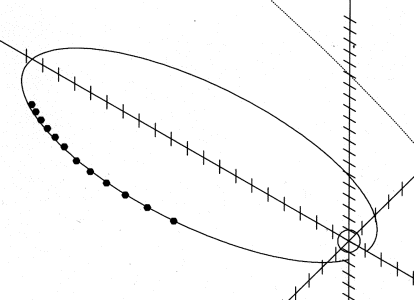 The initial concept called for 12 small spinning spacecraft in an elongated near-equatorial orbit (Figure 1, on the right), with apogee of 20 or 25 RE.
Instruments included a magnetometer on a short boom (75 cm) and a half-top-hat combined ion and electron detector. The magnetometer would give magnetic field vectors within 1° and 0.5 nT, while the particle detector´s aperture would cover 14° of the spin angle f and 180° of the orthogonal angle q, so that in a single spin cycle, all 4p steradians of space are covered.
The initial concept called for 12 small spinning spacecraft in an elongated near-equatorial orbit (Figure 1, on the right), with apogee of 20 or 25 RE.
Instruments included a magnetometer on a short boom (75 cm) and a half-top-hat combined ion and electron detector. The magnetometer would give magnetic field vectors within 1° and 0.5 nT, while the particle detector´s aperture would cover 14° of the spin angle f and 180° of the orthogonal angle q, so that in a single spin cycle, all 4p steradians of space are covered.